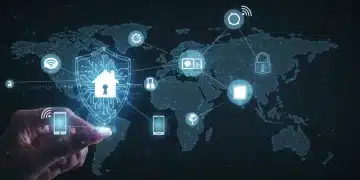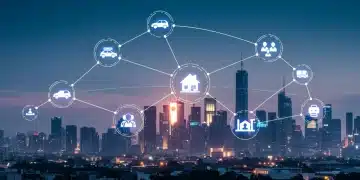IoT Regulations 2025: US Business Compliance Guide

The landscape of IoT Regulations 2025 US businesses must adhere to is rapidly evolving, demanding proactive compliance. This article provides essential updates and insider knowledge to help companies navigate new requirements, ensuring operational continuity and data security.
IoT Regulations 2025 US businesses face are rapidly taking shape, with recent updates indicating a significant shift in compliance demands. As the Internet of Things (IoT) expands its footprint across industries, from smart manufacturing to connected healthcare, the regulatory environment is catching up. This report distills the critical compliance updates, offering a clear, actionable roadmap for US businesses to prepare and adapt effectively for the coming year.
Understanding the Evolving Regulatory Landscape
The pace of technological innovation in IoT has consistently outstripped the development of comprehensive regulatory frameworks. However, 2025 marks a pivotal year, as various US federal and state agencies are finalizing or implementing new rules designed to address privacy, security, and data governance challenges inherent in IoT deployments. Businesses must move beyond basic security practices and embrace a holistic compliance strategy.
The fragmented nature of current US regulations has historically posed a challenge, with various sector-specific laws (like HIPAA for healthcare or PCI DSS for payment processing) touching upon IoT indirectly. Now, a more concerted effort is underway to establish baseline requirements applicable across a broader spectrum of IoT devices and services. This includes initiatives from the National Institute of Standards and Technology (NIST) and potential new legislative acts aimed at standardizing security postures and data handling practices.
Key Federal Initiatives Shaping IoT Compliance
- NIST Cybersecurity Framework (CSF) Updates: The CSF continues to be a cornerstone for cybersecurity practices, and its latest iterations include specific guidance for IoT security, emphasizing risk management and supply chain integrity. Businesses are expected to align their IoT security programs with these updated guidelines, moving towards a more robust and standardized approach.
- Federal Trade Commission (FTC) Enforcement: The FTC is increasingly active in addressing deceptive practices and inadequate security in consumer-facing IoT devices. Their enforcement actions serve as a strong signal for all businesses to ensure transparency in data collection and implement reasonable security measures to protect user information.
- Potential for New Federal Legislation: Discussions around a unified federal IoT security and privacy law are gaining traction. While no single comprehensive bill has passed, businesses should monitor legislative developments closely, as any new law could significantly alter compliance requirements, particularly concerning data minimization, consent, and breach notification for IoT data.
The shift towards a more structured regulatory environment is not merely about avoiding penalties; it’s about building consumer trust and fostering a secure digital ecosystem. Businesses that proactively embrace these changes will gain a competitive advantage, demonstrating their commitment to responsible innovation.
Critical Compliance Updates for Data Privacy
Data privacy remains a paramount concern within the IoT ecosystem. With devices collecting vast amounts of personal and sensitive information, regulators are intensifying their focus on how this data is handled, stored, and shared. US businesses must navigate a complex web of existing and emerging state-level privacy laws, alongside the potential for federal intervention, to ensure compliance in 2025.
The California Consumer Privacy Act (CCPA), augmented by the California Privacy Rights Act (CPRA), set a high bar for data privacy, granting consumers significant control over their personal information. Other states, including Virginia (VCDPA), Colorado (CPA), Utah (UCPA), and Connecticut (CTDPA), have followed suit with their own comprehensive privacy statutes. These laws often include specific provisions that directly impact IoT data, such as requirements for transparent data collection notices, opt-out mechanisms for data sales, and robust data security practices.
Impact of State-Level Privacy Laws on IoT Data
- Consumer Consent and Transparency: IoT devices often collect data passively. New regulations demand clear, unambiguous consent for data collection, especially for sensitive personal information. Businesses must provide easily accessible privacy policies that detail what data is collected, why, and how it is used.
- Data Subject Rights: Consumers are gaining expanded rights to access, correct, delete, and port their IoT data. Companies must establish efficient mechanisms to respond to these requests within defined timeframes, ensuring compliance with each state’s specific requirements.
- Data Minimization and Retention: The principle of data minimization—collecting only what is necessary—is becoming a regulatory expectation. Businesses should review their IoT data collection practices to ensure they are not over-collecting and implement clear data retention policies that align with legal and business needs, not simply indefinite storage.

The proliferation of state privacy laws means that businesses operating nationally must adopt a comprehensive approach that satisfies the strictest requirements, or risk managing a patchwork of compliance obligations. This necessitates a thorough understanding of each state’s nuances and how they apply to specific IoT data flows.
Strengthening Cybersecurity in IoT Deployments
Cybersecurity is no longer an optional add-on for IoT devices; it is a fundamental requirement reinforced by upcoming regulations in 2025. The increasing sophistication of cyber threats targeting IoT devices necessitates a proactive and robust security posture from design to deployment and beyond. Regulatory bodies are pushing for mandating security-by-design principles, secure development lifecycles, and ongoing vulnerability management.
The growing number of high-profile IoT breaches has underscored the vulnerability of interconnected systems. These incidents can lead to significant financial losses, reputational damage, and even risks to public safety. Consequently, regulatory focus is shifting towards establishing baseline security standards, ensuring that devices are not only functional but also inherently secure against common attack vectors. This includes provisions for strong authentication, encryption of data in transit and at rest, and secure firmware updates.
Key Cybersecurity Mandates and Best Practices
- Secure Product Development Lifecycle (SPDLC): Businesses are expected to integrate security considerations into every phase of the IoT device lifecycle, from initial design and development to testing, deployment, and end-of-life. This includes threat modeling, secure coding practices, and regular security audits.
- Vulnerability Management and Patching: Maintaining the security of IoT devices post-deployment is crucial. Regulations will increasingly require manufacturers and operators to have robust processes for identifying, assessing, and remediating vulnerabilities through timely security patches and firmware updates.
- Supply Chain Security: The security of IoT devices is only as strong as its weakest link. Businesses must scrutinize their supply chains, ensuring that all components and third-party services integrated into their IoT solutions meet stringent security standards. This includes due diligence on vendors and contractual obligations for security.
Adopting a strong cybersecurity framework for IoT is not just about meeting regulatory mandates; it’s about safeguarding assets, protecting customer data, and maintaining operational integrity in an increasingly connected world. Proactive security measures will be a differentiator in the market.
Sector-Specific IoT Regulations and Their Implications
While general IoT regulations are emerging, several sectors are also seeing intensified, industry-specific compliance requirements in 2025. These tailored regulations acknowledge the unique risks and data sensitivities inherent in areas like healthcare, critical infrastructure, and automotive. Businesses operating in these sectors must pay close attention to these specialized mandates, which often go beyond general cybersecurity and privacy laws.
For instance, in healthcare, the integration of medical IoT (IoMT) devices demands strict adherence to HIPAA, but new guidelines are expected to clarify how HIPAA applies specifically to device security, data encryption, and remote patient monitoring. Similarly, the energy and utilities sectors, deemed critical infrastructure, are facing enhanced cybersecurity directives from agencies like the Department of Energy and the Cybersecurity and Infrastructure Security Agency (CISA) to protect against foreign state-sponsored attacks.
Navigating Industry-Specific Compliance
- Healthcare (IoMT): Expect stricter guidelines on device authentication, secure data transmission from patient-worn sensors, and explicit consent mechanisms for health data collection, potentially under expanded HIPAA interpretations or new dedicated IoMT security laws.
- Critical Infrastructure: Operators of IoT in critical sectors (e.g., smart grids, water management) face mandatory reporting of cyber incidents, enhanced network segmentation requirements, and regular security assessments to mitigate systemic risks.
- Automotive: The rise of connected vehicles brings complex data privacy and cybersecurity challenges. Regulations are evolving to address vehicle data ownership, over-the-air (OTA) update security, and protection against vehicle hacking, potentially requiring compliance with new standards from NHTSA or state DMVs.
Understanding and implementing these sector-specific regulations is crucial for businesses to operate legally and responsibly within their respective domains. Ignoring these specialized mandates can lead to severe penalties and operational disruptions, highlighting the need for expert legal and technical guidance.
Auditing and Enforcement Trends in 2025
As IoT Regulations 2025 US businesses face become clearer, regulatory bodies are also enhancing their auditing and enforcement capabilities. Companies can expect more frequent and rigorous compliance audits, increased penalties for non-compliance, and a greater emphasis on accountability for data breaches and security failures. The era of lax enforcement is definitively over.
Regulators are moving towards a more proactive enforcement model, characterized by industry-wide sweeps, targeted investigations based on consumer complaints or reported vulnerabilities, and collaborative efforts between federal and state agencies. This means that even smaller businesses leveraging IoT solutions will not be exempt from scrutiny. Furthermore, there’s a growing trend towards personal liability for executives in cases of gross negligence or repeated non-compliance, underscoring the seriousness of these regulations.
Preparing for Enhanced Audits and Enforcement
- Internal Compliance Audits: Regularly conduct internal audits of your IoT systems and data practices to identify and address vulnerabilities before external regulators do. This includes reviewing data flows, security controls, and adherence to privacy policies.
- Documentation and Record-Keeping: Maintain meticulous records of all compliance efforts, including risk assessments, security policies, incident response plans, and training logs. Comprehensive documentation will be critical in demonstrating due diligence during an audit.
- Incident Response Planning: Develop and regularly test a robust incident response plan specifically for IoT-related security incidents and data breaches. Rapid and effective response can mitigate damages and demonstrate a commitment to security, potentially influencing enforcement outcomes.

Staying informed about the latest enforcement trends and preparing comprehensively for potential audits is essential. Businesses that can demonstrate a strong, documented commitment to compliance will be better positioned to navigate the evolving regulatory landscape successfully.
Proactive Strategies for IoT Compliance
For US businesses, navigating the complex and evolving landscape of IoT regulations in 2025 requires a proactive and strategic approach. Waiting for mandates to be fully enforced is a recipe for disruption and potential penalties. Instead, companies should embed compliance into their core business operations, viewing it as an integral part of their IoT strategy rather than a burdensome afterthought.
Developing a comprehensive compliance framework involves cross-functional collaboration, bringing together legal, IT, security, and product development teams. This ensures that regulatory requirements are considered at every stage of the IoT product lifecycle, from initial concept to deployment and ongoing management. Furthermore, investing in continuous training and awareness programs for employees is vital, as human error often remains a significant vector for security and privacy breaches.
Implementing a Forward-Looking Compliance Framework
- Establish a Dedicated Compliance Team: Appoint a cross-functional team or individual responsible for monitoring regulatory changes, conducting risk assessments, and overseeing the implementation of compliance measures across all IoT initiatives.
- Technology Solutions for Compliance: Leverage specialized software and platforms that can help automate compliance tasks, such as data mapping, consent management, vulnerability scanning, and secure configuration management for IoT devices.
- Regular Legal Counsel Engagement: Partner with legal experts specializing in IoT and data privacy to stay abreast of the latest regulatory interpretations and to ensure your compliance strategies are legally sound and robust against future changes.
By adopting these proactive strategies, US businesses can transform compliance from a reactive burden into a strategic asset. A strong compliance posture enhances trust, reduces risk, and positions companies as leaders in responsible IoT innovation.
Key Compliance Area |
Brief Action Required |
|---|---|
Data Privacy |
Implement clear consent, data minimization, and robust subject rights mechanisms. |
Cybersecurity |
Adopt secure-by-design, SPDLC, and proactive vulnerability management. |
Sector-Specific Rules |
Adhere to tailored regulations for healthcare, critical infrastructure, and automotive IoT. |
Enforcement Readiness |
Conduct internal audits, maintain meticulous records, and develop robust incident response plans. |
Frequently Asked Questions on IoT Regulations 2025 US
The most significant changes include enhanced data privacy requirements, stronger cybersecurity mandates for device manufacturers and operators, and increased sector-specific regulations, particularly in healthcare and critical infrastructure. A move towards more unified federal guidance is also anticipated, impacting how businesses handle IoT data and device security.
State privacy laws like CCPA/CPRA, VCDPA, and others significantly impact IoT businesses by demanding explicit consumer consent for data collection, providing robust data subject rights, and enforcing strict data minimization principles. Businesses must ensure their IoT data practices comply with the strictest state regulations to avoid a patchwork approach across states.
▼
NIST provides crucial guidelines through its Cybersecurity Framework, which is increasingly being referenced by regulators for IoT security. Their recommendations emphasize risk management, supply chain security, and secure development lifecycles. Aligning with NIST standards helps businesses build robust security postures that satisfy evolving regulatory expectations for IoT devices.
▼
Non-compliance can lead to severe financial penalties, significant reputational damage, legal liabilities, and operational disruptions. Regulatory bodies are increasing their enforcement actions, with potential for targeted investigations and even personal liability for executives in cases of gross negligence. Proactive compliance is essential to mitigate these risks.
▼
Businesses should establish a dedicated compliance team, conduct regular internal audits, maintain detailed records of compliance efforts, and develop a robust incident response plan for IoT-related breaches. Engaging legal counsel specializing in IoT regulations and investing in compliance technology solutions are also critical proactive steps.
Looking Ahead: The Future of IoT Compliance
The landscape of IoT Regulations 2025 US businesses must navigate is dynamic and complex, but also presents an opportunity. Proactive engagement with these compliance updates is not just about avoiding penalties; it’s about building a foundation of trust and security that will define success in the increasingly connected world. Businesses that embrace these changes will be better positioned to innovate responsibly, protect their customers, and secure their future in the burgeoning Internet of Things market. The coming year will undoubtedly set new precedents, and vigilance will be key to staying ahead.





